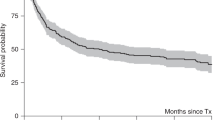Abstract
Twenty-six patients with breast cancer who had relapsed after previously receiving high-dose chemotherapy and autologous hematopoietic cell support received a second course of high-dose cytoreductive therapy and autologous hematopoietic cell support as salvage therapy. Several different high-dose therapy regimens were employed for the second transplant, including a radiolabeled immunoconjugate. Two patients died of treatment-related complications. The remaining 24 patients relapsed a median of 126 (range 22–635) days after salvage transplant. All have since died. The median survival after salvage transplant was 362 (range 31–931) days. We conclude that second courses of high-dose therapy as salvage treatment are generally well-tolerated but their efficacy is modest. Alternative treatment strategies are needed for these patients.
Similar content being viewed by others
Author information
Authors and Affiliations
Rights and permissions
About this article
Cite this article
Bearman, S., Vredenburgh, J., Cagnoni, P. et al. High-dose therapy with autologous hematopoietic cell support as salvage treatment for patients with breast cancer who have relapsed after previous high-dose chemotherapy. Bone Marrow Transplant 24, 491–495 (1999). https://doi.org/10.1038/sj.bmt.1701937
Received:
Accepted:
Published:
Issue Date:
DOI: https://doi.org/10.1038/sj.bmt.1701937
- Springer Nature Limited




